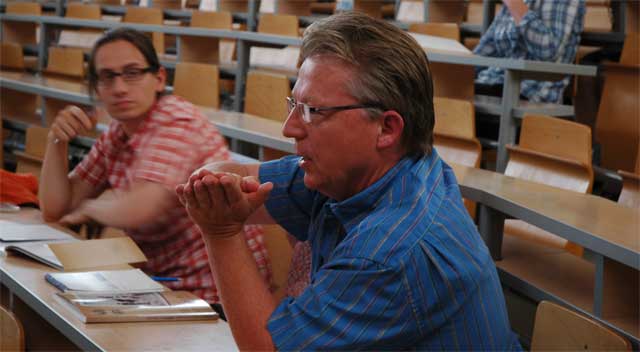LOESSFEST'09 | Aug. 31st – Sept. 3rd, 2009 |Novi Sad-Serbia
Pleistocene Transition from the Stari Slankamen Loess Site
Hambach, U.1, Jovanović, M.2, Marković, S.B.2, Nowaczyk, N.3, Rolf, C.4
1Chair of Geomorphology, University of Bayreuth, D-95440 Bayreuth, Germany
2Chair of Physical Geography, Faculty of Sciences, University of Novi Sad, Serbia
3GeoForschungsZentrum Potsdam, Potsdam, Germany
4Leibniz Institute for Applied Geosciences (LIAG), Hannover, Germany
The Matuyama-Brunhes geomagnetic reversal is the most important time marker in Quaternary sedimentary sequences. It provides unambiguous correlation between marine, lacustrine, loess and even fluvial deposits because its recognition does ideally not depend on sediment properties but only on their recording capability. The recognition of the Matuyama-Brunhes boundary (MBB) in the Chinese Loess Plateau (CLP) by Friedrich Heller and Tung-Sheng Liu (HELLER & LIU 1982) started the success story of magnetic polarity dating in continental Quaternary sequences. They assigned the Chinese loess successions to the Quaternary time table and correlated it with the global ice volume record using the magnetic susceptibility signal as a palaeoclimate proxy (HELLER & LIU 1984).

At the western edge of the Eurasian loess belt, in the southern Carpathian basin in the region called Vojvodina we find several decametres thick loess deposits dating back to the Middle Pleistocene at least (Marković et al., 2009). Like in the CLP in the Vojvodina one can find true loess plateaus reaching thicknesses of more than 50 m. The exposure at Stari Slankamen is located in the north-eastern part of Srem Loess Plateau, on the right bank of the Danube River. The loess sequence is comprised of multiple couplets of loess and palaeosol units totaling approximately 40 m thickness of sediments. 8 palaeosol units can be distinguished separated by several metres thick loess layers. The lower 5 palaeosol units are developed as strongly rubified forest soils with decreasing degree of pedogenesis from old to young. In contrary, the younger palaeosol units including the recent soil are developed as steppe soils. This strongly suggests that a considerably longer palaeoclimatic record is preserved at the site than is found elsewhere in Europe.
Magnetic susceptibility (MS) of the whole section was measured in the field as well as in the laboratory at 10 cm intervals in the palaeosol units and at 15 cm intervals in the loess. In 2005, high resolution sampling was carried out covering almost 11 m from the lowest part of the profile and involving palaeosol units V(ojvodina)S8 to VS6. A total of 434 samples were collected from 2 parallel columns using oriented tubes with sampling step every 5 cm. Measurements of standard rock-magnetic parameters were performed and detailed palaeomagnetic analyses including thermal and AF demagnetization on parallel samples were carried out.
The cyclicity of alternating high and low MS values with palaeosols and loess units respectively reflects magnetic enhancement via varying degrees of pedogenesis, similar to that observed in Chinese and Central Asian loess deposits and corresponding perfectly to recently published records from the same region (Marković et al., 2009). MS values in interglacials decrease through time. This supports the previous assertion, based on palaeopedological observations by Bronger (2003), that climate over the Pleistocene has become progressively more arid in the region. A stratigraphic correlation based only on the MS pattern reveals an unambiguous chronology assigning palaeosol units down to VS5 to marine isotope stages (MIS) 1 to 15. For the lower units, however, such a correlation neither to the Chinese loess nor to loess sections in south-eastern Europe is possible (e.g. Sartori et al., 1999; Jordanova et al., 2007).
Palaeomagnetic analyses of the loess and palaeosol units VS6 to VS8 reveal a pattern of reversed, normal and mixed polarity. However, not all stratigraphic levels reveal clear directional information probably caused by strong pedogenetic and diagenetic overprints. About 1 m of normal polarity at the section base is followed by 3.5 m of reversed polarity which in turn is overlain by about 1.5 m of mixed polarity. Above this interval exclusively normal polarity was found. Within the reversed interval a short (from 3 - 3.5 m) normal interval occurs. The normal interval at the section base belongs to the palaeosol unit VS8 which is in total 4 m thick at least. The mixed polarity interval as well as the transition to normal polarity occurs inside the loess unit VL8 just below the palaeosol unit VS7 which consist of two individual soils separated by a 0.2 m thin loess layer. Root channels stemming from this double soil penetrating several metres down into VL8.
Taking into account the palaeosol-loess stratigraphy, the course of MS variations with depth and the polarity pattern we interpret the double soil VS7 as the equivalent of MIS 19 and 21 corresponding to S7 and S8 in the Chinese loess stratigraphy. Strong pedogenesis and biological activity (root channels) transferred the MBB to the loess below VS7 which corresponds to L9 in China. Consequently, the normally magnetised VS8 complex at the base of the section is interpreted as the amalgamated equivalent of S10 and S11 in China which span the Jaramillo subchron (e.g. Sun et al. 2006). The chronostratigraphic interpretation of the still imperfect magnetic polarity record is corroborated by a relative palaeointensity (RPI) record which matches quite well to RPI records from marine archives. Moreover, the correlation of the rock magnetic parameters (MS, IRM/MS) from the Stari Slankamen sites to the MS-record of the CLP surprisingly supports almost perfectly the interpretation of the palaeomagnetic data and confirms the importance of the Vojvodinian loess province for palaeoclimatic studies.
The loess sites at Stari Slankamen reveal probably the oldest loess of the region found so far and open the perspective for palaeoclimatc reconstructions going back 1 Ma at least.



